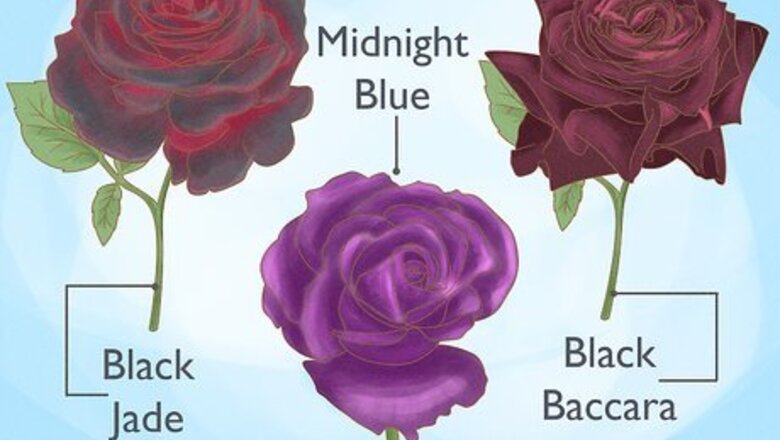
views
Growing Dark Roses

Choose a dark rose variety. There's no such thing as a 100% black rose, although breeders and genetic engineers are trying to make one. However, the right growing techniques can make an extremely dark flower, with just a hint of red or burgundy. Start with a rose variety that produces dark flowers with a velvety texture. Ask a florist for more advice, or track down one of these varieties: Black Jade is one of the most popular dark roses, but can be vulnerable to pests and disease. It turns dark in hot weather. Black Baccara is likely the darkest commonly available rose, but the flowers are small and unscented. It appears darker in cooler weather. Midnight Blue is one of the darkest purple roses available. It has an unusual clove scent. Other options include Nigrette, Black Magic, Black Pearl, Black Ice, Black Beauty, Blackout, and Taboo. Before buying any rose, check climate requirements and size.

Plant in a greenhouse if possible. The exact color your rose ends up can depend on chance factors such as temperature and light. For best results, plant it in a greenhouse where you can control these factors precisely. Always look up your variety or ask a garden nursery for information on space requirements, soil type, and sun levels. In general, when planting your roses you’ll want a soil with good drainage. The soil pH should also be slightly acidic to neutral. Dig a hole that is slightly wider than the plant’s root ball, but about as deep. For a rose bush, this will typically be about 15 to 18 inches (38 to 46 cm) deep and 18 to 24 inches (45.7 to 61.0 cm) wide. Then, when you’ve placed the plant and filled in the hole, add 1 to 2 inches (2.5 to 5.1 cm) of mulch and fertilizer.

Consider watering with floral dye. Some online sources recommend adding black food coloring to the water used to care for the roses. This is unlikely to work, since the roots will not absorb most dyes. If you want to try this, your best bet is to ask a florist for a professional florist dye. These are usually intended for cut flowers, not living plants, but they are less likely to harm your rose.

Wait until buds starts to swell. When the closed buds first appear, the plant is still focusing its energy on growing the flower stems. When the stem has stopped growing and the bud begins to swell, the plant has reached a critical stage of development. 90% of the pigments that determine flower color are created after the bud is ¾ size, but before it opens. If you have a rose variety that blooms multiple times a season, note the bud development on a calendar and use it to track the development of the next round of flowers. This final stage of bud growth will usually take place about two weeks before the flower opens.

Experiment with temperature as the buds grow larger. During this stage, temperature can drastically affect color. Most rose varieties have not been researched in this way, so you'll have to be a pioneer. If possible, try different techniques on different buds or bud clusters. Here are some guidelines to get you started: Cool temperatures tend to increase the amount of pigment produced, which usually means darker flowers. One study of Crimson Glory roses produced purplish roses at 73ºF (23ºC), and darker, redder roses at 50ºF (13ºC). This is more likely to work in summer. Heat stress usually leads to faded or more orange flowers, but there are exceptions. For example, Baccara roses may end up deepening to a bluer shade. This is a risky technique that can cause flower or plant death; if possible, ask a florist to help you choose temperatures that will stress the plant without killing it. One study of (orange-colored) Jaguar roses exposed buds to three days of 102ºF (39ºC) daytime / 64ºF (18ºC) nighttime temperatures.
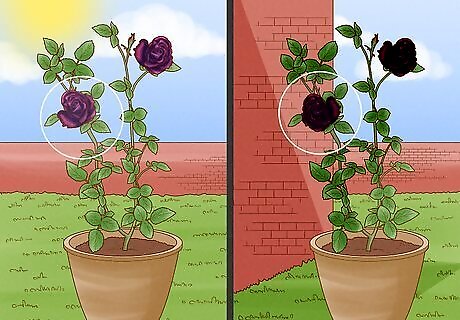
Experiment with light. During bud development, keep Baccara roses shaded for a darker, bluer color. Other varieties may require sunlight in order to develop any color at all. When in doubt, try shading a few branches but keep the rest of the plant in sunlight.
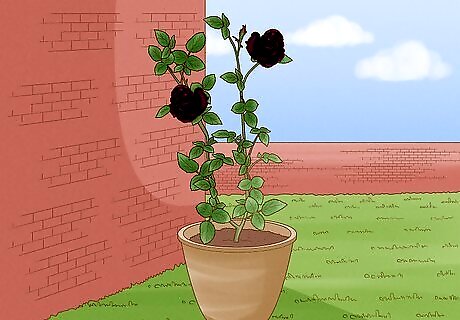
Protect the open bloom from sunlight. The darker the flowers, the more heat they will absorb from the sun. After the living flowers are open, keep them in partial shade. Alternatively, cut them and try one of the methods below to make them even darker. Some roses will bloom dark red in spring and fade to black during summer. If you're unsatisfied with the appearance of your roses, you may want to risk exposing them to sunlight.

Prune your plant. Pruning will keep your roses healthy. Pruning helps to encourage new growth and blooms, remove dead wood, and improve air circulation. Roses are usually pruned during the spring, though a lot depends on the variety you are growing. Always use clean and sharp tools. Remove all dead, broken, diseased, or dying canes as well as weak or twiggy branches that are thinner than a pencil. Also remove any suckers from the plant. Then, you’ll want to prune the healthy canes – keeping in mind that new branches sprout from the eye buds. Prune from the bottom of the plant up and make your cuts at a 45 degree angle, about ¼ of an inch above a bud facing out from the plant.
Darkening Cut Roses

Start with cut, dark roses. This method describes how to preserve dark roses, and encourage them to fade to a darker near-black shade. The rose varieties mentioned above are good choices. A partially opened flower may remain darker and better-preserved than a fully open flower. If you're buying the roses from a store and can't find any dark varieties, choose roses with velvety petals. This texture will make them appear darker.

Try aging your flowers in water or preservative (optional). If your flowers are already quite dark, skip to the next step. If they're much lighter than you'd like, you can try keeping them in water for a few days instead. The effect is usually small and can be hard to predict, but this will usually make your flowers slightly bluer and darker. Water usually has a darker effect than flower preservative, but this can vary between flower varieties. Try one vase of each if you have plenty of flowers to spare. Flower preservative is available from florists and nurseries. Homemade solutions involving acid and sugar may have a similar effect. For more advice on keeping cut roses in water, read this article.
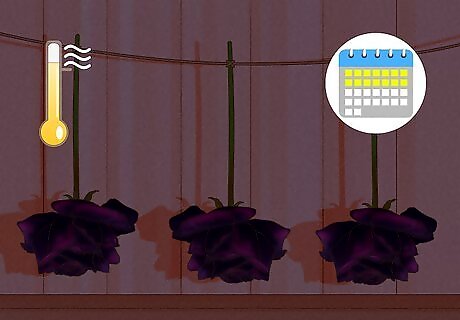
Dry the flowers upside down. Whether or not you kept your flowers in liquid, air drying them can often lead to darker colors. Hang the flowers upside-down in a warm, dry place away from light. It may take two weeks or more before the flowers are fully dry.
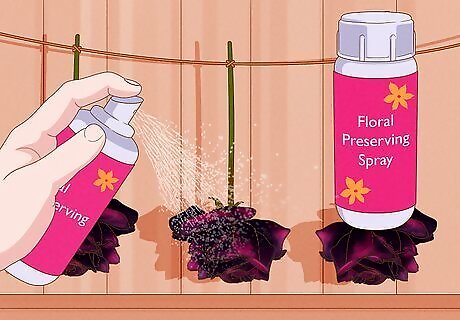
Spray with floral preserving spray (optional). Once the flowers are dry, a florist spray will help keep them around longer. Apply to the dry blossom according to label instructions. Do not try to dust the flower first, which can easily damage the petals.
Dyeing Cut Roses Black
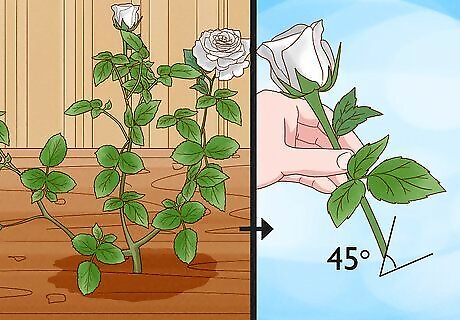
Choose your roses. A white or light-colored rose is usually the best choice. Since these have little color to begin with, it will be easier to get the color you want. This is especially true of dyeing, which can be difficult to detect in a dark rose. If cutting the roses yourself, use disinfected gardening shears. Scissors may crush the stem, preventing uptake of water and dye. Cut roses at a 45º angle to allow for more surface area for water and dye uptake.

Find the dye. Although some people have tried black food coloring in water, a professional floral dye is safer for the plant. You can order these online, or ask a florist to order it for you.
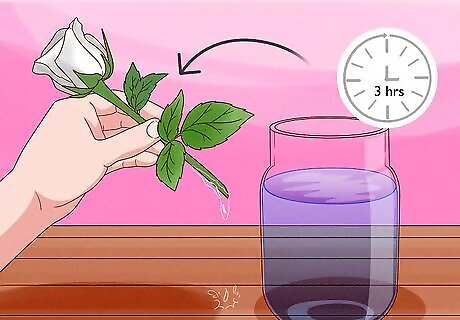
Leave the cut flowers out of water. Wait at least three hours after cutting the roses or bringing the back from the florist. Stressed flowers will draw up more water, and therefore more dye.
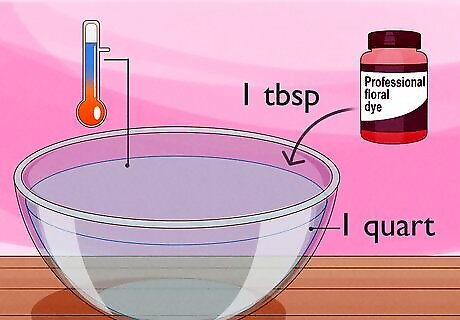
Mix warm water and dye. Check the label on your dye for a recommended concentration. When in doubt, go with 1 tbsp (15mL) floral dye for 1 quart (1L) warm water. The water should feel hot but not uncomfortable, about 100ºF (38ºC). Mix the ingredients thoroughly in a heat-safe container large enough for your roses. Add flower preservative as well for a longer lifespan.
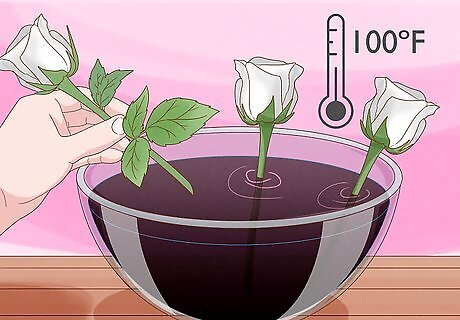
Leave the roses in the liquid, maintaining heat. Since roses have thick, woody stems, they can take several hours (or even a full day) to change color. To prevent blotchy, incomplete dying, keep the temperature at around 100ºF (38ºC). You can periodically add warm water to achieve this, or put the whole container in a slow cooker set to this temperature.
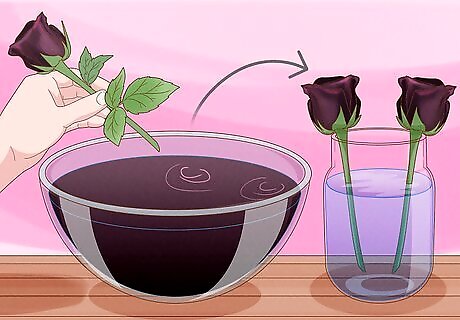
Remove the roses. Once the roses have turned black, remove the bouquet. Rinse the dye off the stems and transfer to an ordinary vase of water. If the flowers are blotchy, leave them in plain, warm water overnight to spread the color more evenly.


















Comments
0 comment